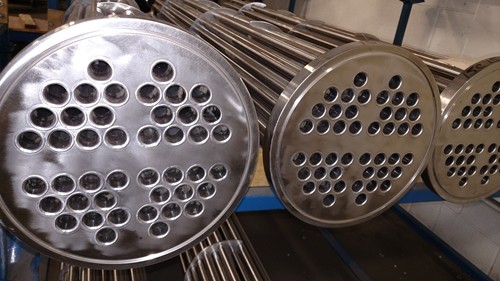A quality product doesn’t just happen by chance. The materials used to make it need to be carefully chosen; the plant or factory where it’s made needs to be intelligently designed; and the equipment needed to manufacture the product needs to be top-notch.
Once these three requirements are filled, your operation is in good shape. But all equipment has a lifespan, and over time, it’ll start to wear out. Ensuring that all pieces of equipment are working properly is crucial in any operation.
Ordering new equipment or replacement parts can become a tricky business. It takes time to build a large piece of processing machinery, such as a shell and tube heat exchanger. And making a specialized design can take even longer. Chemical Processing pointed out that some of the biggest pieces of processing equipment can have lead times of as long as 24 months – longer in some cases. A lot can happen in two years of waiting for an item, and your time is precious.
It’s important that months aren’t wasted spent waiting for a critical piece of equipment to arrive. To avoid too-long lead times, be sure to follow some best practices and keep some strategies in mind.
Know when you’ll need it
You don’t need a crystal ball to get a good idea of when you’ll need to replace equipment. You should know the age and condition of most pieces already. You are also probably familiar with the average lifespan of the types of equipment you use. Some simple math can give you a general range for when your equipment may begin to age out.
“Keep in mind that your machine could be an outlier.”
Knowing when a machine’s performance is likely to begin diminishing is a good start, but not every machine runs the same. Many factors determine how a machine will normally operate. Differences in the environment in which it’s used, where it was built and by whom will all play important roles. Learn the average lifespan to get a good idea, but keep in mind that your machine could be an outlier.
Regular inspections are key to detecting when an item needs to be repaired or replaced. Even when the equipment is brand new, be sure to inspect it on a regular basis. As it gets older, it might be a good idea to increase the frequency of inspections.
Create an ordering schedule
Since you can determine the general timeframe that you’ll need to order a piece of equipment, it shouldn’t be hard to draft up a guideline or schedule for when you’ll need to order certain pieces of equipment.
Once you have this clearly written out, it’ll be easier to determine when and how much you should be saving up for the next equipment purchase. If you know around when you’ll need a new piece of equipment or replacement part, you’ll be able to order it ahead of time. That way, you won’t have to put any equipment out of commission while you wait for your order to come in, and you can replace broken machinery quickly.
You can also communicate this information to your manufacturer so they are aware of your needs. Plus, they’ll have a good idea of how much time it’ll take to produce and ship what you need – valuable information to have when ordering equipment.
“Work with a company you trust can produce quality equipment.”
Be prepared for emergencies
No one can predict the future, and even the most careful manufacturers might have to handle a costly mistake or damaged piece of equipment at some point. When something like this happens, it’s important to move fast to make up for lost production time. Having an emergency budget set aside can help maintain your financial stability. And working with a company that you trust can produce quality equipment on a quick schedule is crucial. They can also assist you by recommending what spare parts to have on hand, in the event of an emergency.
Work with a company you can trust
No matter what industry you’re in, the importance of building a good relationship with your business partners can’t be overstated. The stronger your relationship with the company, and the longer you work with it, the more it’ll learn about your unique process and the better it will be able to help you. Also, when you get to know a company, you’ll get to know its process a little bit better, which will only make collaboration smoother.
When it comes to your shell and tube heat exchangers, if you’re unsure of the best way to initiate the order process, or want to learn about how to reduce the impact of lead times, contact the engineers at Enerquip

